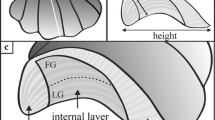Abstract
Periodic increments in the growth of organismal shells and fossils in the intertidal zone were studied by light microscopy, scanning electron microscopy and chemical composition analyses. The results were used to calculate the orbital parameters of the Earth-Moon system from the Ordovician to Quaternary period. The annual, semi-annual, biweekly (14-day), daily and subdaily growth rhythms were identified on the surface of shells. The periodic changes in the growth increments of shells and the rhythmic variations of microelements in fossils and organisms were reliable indicators of environmental changes. There were 415.69 days for an annual period in Ordovician, 407.1 days in Devonian, 400.51 days in Carboniferous-Permian, 393.98 days in Tertiary, 374.13 days in Triassic and 367.4 days in Quaternary. The data collected and calculated from these growth increments show that – from the Ordovician to the Quaternary period – the rate of Earth’s rotation has been slowing down and that the distance from the Earth to the Moon has been increasing, while the rate of lunar retreat has been decreasing.







Similar content being viewed by others
References
Allen JRL (1981) Lower Cretaceous tides revealed by crossbedding with mud drapes. Nature 284:579–581
Barker RM (1964) Microtextural variations in pelecypoda shells. Malacologia 2:69–86
Berry WBN, Barker RM (1975) Growth increments in fossil and modern bivalves. In: Rosenberg GD, Runcorn SK (eds) Growth rhythms and the history of the Earth's rotation. John Wiley and Sons, New York, pp 9–25
Donald CR, Richard AL (1980) Skeletal growth of aquatic organisms. Plenum Press, New York, pp 200–500
James CG, Zahnle WKJ (1986) Lunar nodal tide and distance to the moon during the Precambrian. Nature 320:600–602
Kennish MJ (1977) Growth increment analysis of Mercenaria mercenaria from artificially heated coastal marine waters: a practical monitoring method. In: Halberg F (ed) Proc 12th Int Conf Int Soc Chronobiol. Washington D.C., pp 663–669
Owen R, Kennedy H, Richardson C (2002) Isotopic partitioning between scallop shell calcite and seawater: effect of shell growth rate. Geochim Cosmochim Acta 66:1727–1737
Pannella G (1972) Paleontological evidence on the earth’s rotational history since early Precambrian. Astrophys Space Sci 16:212–237
Pannella G (1975) Palaeontological clocks and the history of the Earth's rotation. In: Rosenberg GD, Runcorn SK (eds) Growth rhythms and the history of the Earth's rotation. John Wiley and Sons, New York, pp 253–284
Potyondy DO (1995) Discrete crack growth analysis methodology for through cracks in pressurized fuselage structure. Int J Numer Methods Eng 38:11–33
Rhoads DC, Pannella G (1970) The use of molluscan shell growth patterns in ecology and paleoecology. Lethaia 3:143–161
Richardson CA, Peharda M, Kennedy H, Kennedy P, Onofri V (2004) Age, growth rate and season of recruitment of Pinna nobillis (L) in the Croatian Adriatic determined from Mg:Ca and Sr:Ca shell profiles. J Exp Mar Biol Ecol 299:1–16
Rosenberg GD, Runcorn SK (eds) (1975) Growth rhythms and the history of the earth’s rotation. John Wiley and Sons, New York, pp 559–605
Runcorn SK (1964) Changes in the Earth's moment of inertia. Nature 204: 823–825
Runcorn SK (1970) Palaeontological measurements of the changes in the rotation rates of earth and moon and of the rate of retreat of the moon from the earth. In: Runcorn SK (ed) Paleogeophysics. Academic, New York, pp 17–23
Salgado NK, Aliabadi MH (1996) The application of the dual boundary element method to the analysis of cracked stiffened panels. Eng Fract Mech 54:91–105
Thomas G, Mehmet S (2000) Growth dynamics of red abalone shell: a biomimetic model. Mater Sci Eng C11:145–153
Thurman HV (1991) Introductory oceanography. Macmillan, New York, pp 242–268
Wells JW (1963) Coral growth and geochronometry. Nature 197:948–950
Xu DY, Yang ZZ, Zhang WQ (1983) An introduction to astrogeology. Geologic Publishing House, Beijing, pp 1–200
Yi ZX, Luo JD (1976) The reliability of ancient biological clocks is testified by astronomy observation and biological rhythm. Sci Geol Sin 1:1–21
Zhou YQ, Chen HY, Ji GS (2002) Tidal rhythmicities in Cambrian-Ordovician, north China and evolution of orbital parameters. Geoscience 27:671–675
Author information
Authors and Affiliations
Corresponding author
Rights and permissions
About this article
Cite this article
Zhenyu, Z., Yaoqi, Z. & Guosheng, J. The periodic growth increments of biological shells and the orbital parameters of Earth-Moon system. Environ Geol 51, 1271–1277 (2007). https://doi.org/10.1007/s00254-006-0420-0
Received:
Accepted:
Published:
Issue Date:
DOI: https://doi.org/10.1007/s00254-006-0420-0




